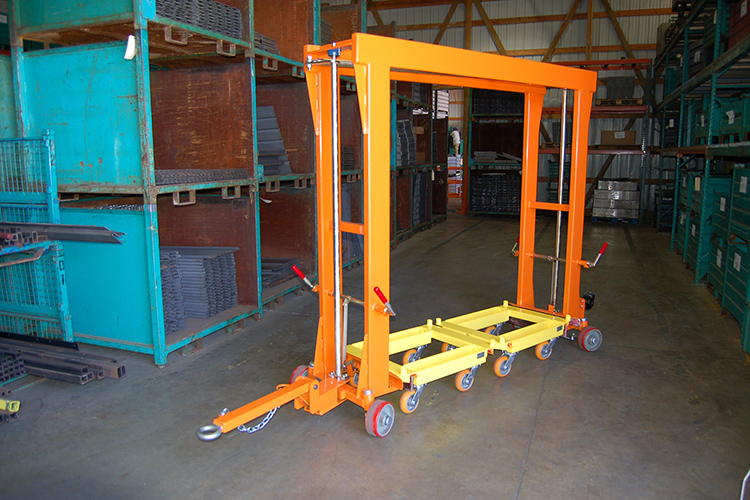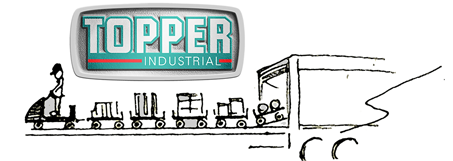Original Article Link Here.

July 1, 2022 | Distribution Centers/Warehouse, Material Handling
By: Jillian Burrow, Contributor
Cart delivery is the movement of material without the use of fork trucks. It is moving material with industrial carts. Delivery carts are pushed or pulled by an operator and when tugged they are always pulled in trains of multiples.
Visual Representation: The Spaghetti Diagram.
This is a spaghetti diagram. It is a visual representation of a workflow showing moving material with a fork truck versus moving material with a tugger and train of carts. Please use the color grid to follow the material flow. The red is non-value added work, it is any movement without parts. The yellow is non-value added but needed, it shows the movement of empties. That could be dunnage, container or simply an empty cart. The green is value added, it shows movement with fulls.
You can simply see by this visual that cart delivery simplifies and mainstreams the workflow.
Cart Delivery Benefits
By mainstreaming your workflow, it will help getting the right part to the right place and the right time. Material handling cart delivery improves safety by reducing operator handling, over exertion, reduced motion and lessening the need to use fork trucks. It also helps to ensure quality, improve flexibility and scalability. Incorporating tugger cart delivery, you can prevent defects, shorten lead times and create more efficient processes throughout your workflow.
Options for Cart Delivery: Two Options
You only have two options for cart delivery. The first option for material movement is to deliver the material on a cart and work out of the cart. The second option is to deliver it on a transfer cart that is equipped with a conveyor roller top and then transfer the material to a conveyor workstation.
Both can be accomplished using a train of tugger carts or a train of tugger Mother carts.
You might be asking yourself why the need to explain the difference between a tugger train of carts and a tugger mother cart system. The reality is it isn’t as much a comparison as a defining each system’s similar and unique characteristics.
Tugger carts are connected by a towbar at front and a coupler at rear. Image courtesy of Topper Industrial.
Train of Tugger Carts: Defined
A train of tugger carts is just what it sounds like. It is numerous carts that are coupled together in tow like a train and can be decoupled and coupled along a work route at various workstations. They are connected by a towbar at front and a coupler at rear. Each cart in tow can be a variety of cart types. This provides flexibility along the work route. When you work with delivery carts along a work route, to deliver the carts you must decouple one of the carts in the train. Therefore, if you have five carts in a row and need to deliver the second cart in tow to a work cell, you must decouple the second cart from the train. After you deliver the cart, you must connect cart one and three together to move again along the route with the four remaining carts. Likewise, you can pick up carts along the same route and couple them within or at the end of the train.
Daughter carts are pulled out and pushed back into the Mother Cart frame. Image courtesy of Topper Industrial.

Train of Tugger Mother Carts: Defined
To explain a tugger Mother Daughter Cart system, you first must know that the Mother Carts are tugged in a train just like a typical train of tugger carts. They are connected by a towbar in front and a coupler in back and can be decoupled, but generally are not. What moves in this system to deliver is the daughter carts.
A Mother Daughter Cart system consists of one or more large mother frame cart that tow in a train. Within the Mother Carts are two or more, smaller daughter delivery carts. The daughter carts are designed to fit within the mother cart’s framework. Once the daughter carts are locked inside, the mother and daughter carts are then able to be tugged as one.
When along a delivery route, the daughter carts are used to deliver empties and fulls. Daughter carts are most often push carts; they are not equipped with a tow package. Daughter carts are pulled out and pushed back into the Mother Cart frame. In a Mother Daughter Cart System, all the Mother Carts are the same style and size. The Daughter carts can be various cart types and can even be different sized.

It is about your Workflow
When deciding between a tugger train of carts and a tugger Mother Cart system, you must consider your workflow. Cart delivery is researched and planned out. You must consider your delivery route. What size are the aisles? How tight are the turns along the route? Which system would work best for your team? Would the flexibility of having different carts that were easily coupled and decoupled for delivery be best? Or would having the ability to on remove daughter carts work more efficiently? WMHS
Jillian Burrow has been working at Topper Industrial since 2006 as the Marketing Manager. She oversees all marketing and public relations for the company. Burrow also manages the company’s editorial and blog site, www.forktruckfree.com. Topper Industrial (www.topperindustrial.com) specializes in the design, building and implementation of material handling carts and equipment.
Contact Topper, we are here to help! sales@topperindustrial.com.
Topper Industrial (www.topperindustrial.com) is a leading manufacturer of material handling equipment. Topper provides lean material handling solutions to the supply chain.
Topper Industrial engineers and design Industrial Carts (Mother Daughter Cart Systems, Quad Steer Carts or Tracking Carts, Specialized Tugger Carts, Transfer Carts with Roller Deck, Static Carts, Rotation Carts, Tilt Carts or Kitting Carts), Industrial Cart Components (Cart Tow Bars, Couplers/ Hitches, Brakes, Etc.), Industrial Containers (Corrugated Steel), Pallets, Lift/Tilt Systems, and Racking. Topper Industrial designs all products with ergonomics in mind, focusing on ease of use and best positioning of material to get the job done.
For further assistance and inquiries on Topper Industrial Material Handling Solutions, please contact sales@topperindustrial.com or visit www.topperindustrial.com.


